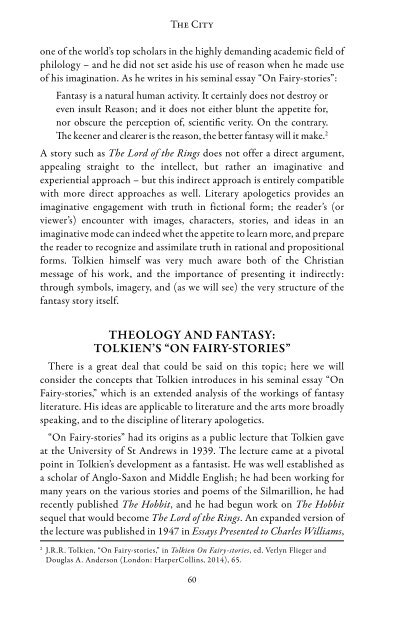THE CITY
h6c7p5d
h6c7p5d
You also want an ePaper? Increase the reach of your titles
YUMPU automatically turns print PDFs into web optimized ePapers that Google loves.
The City<br />
one of the world’s top scholars in the highly demanding academic field of<br />
philology – and he did not set aside his use of reason when he made use<br />
of his imagination. As he writes in his seminal essay “On Fairy-stories”:<br />
Fantasy is a natural human activity. It certainly does not destroy or<br />
even insult Reason; and it does not either blunt the appetite for,<br />
nor obscure the perception of, scientific verity. On the contrary.<br />
The keener and clearer is the reason, the better fantasy will it make. 2<br />
A story such as The Lord of the Rings does not offer a direct argument,<br />
appealing straight to the intellect, but rather an imaginative and<br />
experiential approach – but this indirect approach is entirely compatible<br />
with more direct approaches as well. Literary apologetics provides an<br />
imaginative engagement with truth in fictional form; the reader’s (or<br />
viewer’s) encounter with images, characters, stories, and ideas in an<br />
imaginative mode can indeed whet the appetite to learn more, and prepare<br />
the reader to recognize and assimilate truth in rational and propositional<br />
forms. Tolkien himself was very much aware both of the Christian<br />
message of his work, and the importance of presenting it indirectly:<br />
through symbols, imagery, and (as we will see) the very structure of the<br />
fantasy story itself.<br />
<strong>THE</strong>OLOGY AND FANTASY:<br />
TOLKIEN’S “ON FAIRY-STORIES”<br />
There is a great deal that could be said on this topic; here we will<br />
consider the concepts that Tolkien introduces in his seminal essay “On<br />
Fairy-stories,” which is an extended analysis of the workings of fantasy<br />
literature. His ideas are applicable to literature and the arts more broadly<br />
speaking, and to the discipline of literary apologetics.<br />
“On Fairy-stories” had its origins as a public lecture that Tolkien gave<br />
at the University of St Andrews in 1939. The lecture came at a pivotal<br />
point in Tolkien’s development as a fantasist. He was well established as<br />
a scholar of Anglo-Saxon and Middle English; he had been working for<br />
many years on the various stories and poems of the Silmarillion, he had<br />
recently published The Hobbit, and he had begun work on The Hobbit<br />
sequel that would become The Lord of the Rings. An expanded version of<br />
the lecture was published in 1947 in Essays Presented to Charles Williams,<br />
2<br />
J.R.R. Tolkien, “On Fairy-stories,” in Tolkien On Fairy-stories, ed. Verlyn Flieger and<br />
Douglas A. Anderson (London: HarperCollins, 2014), 65.<br />
60


